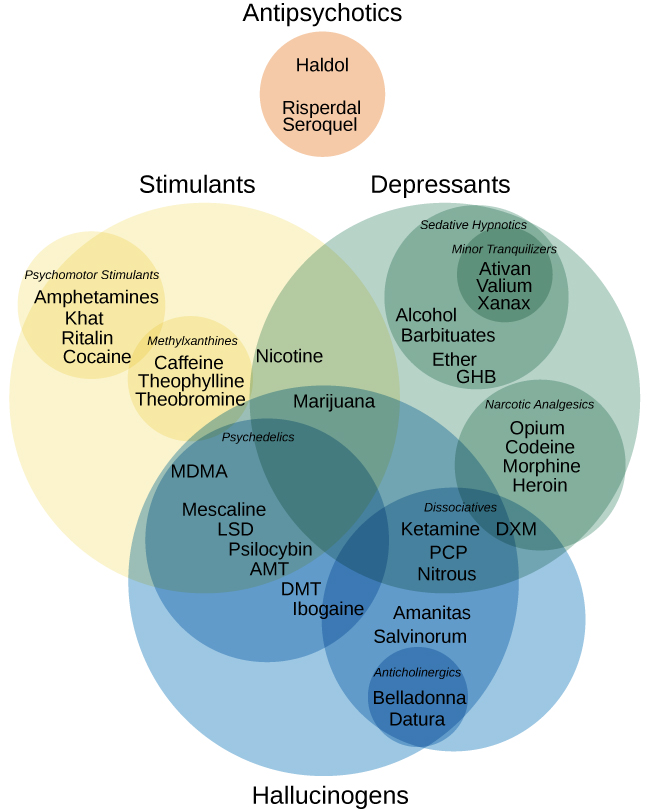7.13: Psychoactive Drugs and Addiction
- Page ID
- 59889
- Describe how substance abuse disorders are diagnosed
Substance Abuse Disorders
The fifth edition of the Diagnostic and Statistical Manual of Mental Disorders, Fifth Edition (DSM-5) is used by clinicians to diagnose individuals suffering from various psychological disorders. Drug use disorders are addictive disorders, and the criteria for specific substance (drug) use disorders are described in DSM-5. A person who has a substance use disorder often uses more of the substance than they originally intended to and continues to use that substance despite experiencing significant adverse consequences. In individuals diagnosed with a substance use disorder, there is a compulsive pattern of drug use that is often associated with both physical and psychological dependence.
Physical dependence involves changes in normal bodily functions—the user will experience withdrawal from the drug upon cessation of use. In contrast, a person who has psychological dependence has an emotional, rather than physical, need for the drug and may use the drug to relieve psychological distress. Tolerance is linked to physiological dependence, and it occurs when a person requires more and more drug to achieve effects previously experienced at lower doses. Tolerance can cause the user to increase the amount of drug used to a dangerous level—even to the point of overdose and death.
Drug withdrawal includes a variety of negative symptoms experienced when drug use is discontinued. These symptoms usually are opposite of the effects of the drug. For example, withdrawal from sedative drugs often produces unpleasant arousal and agitation. In addition to withdrawal, many individuals who are diagnosed with substance use disorders will also develop tolerance to these substances. Psychological dependence, or drug craving, is a recent addition to the diagnostic criteria for substance use disorder in DSM-5. This is an important factor because we can develop tolerance and experience withdrawal from any number of drugs that we do not abuse. In other words, physical dependence in and of itself is of limited utility in determining whether or not someone has a substance use disorder.
Link to Learning
Read through this fascinating comic created by Stuart McMillen about psychologist’s Bruce Alexander’s Rat Park study on addiction.
For more information on Bruce Alexander’s study and a better understanding of addiction, listen to Johann Hari’s TED Talk, “Everything you think you know about addiction is wrong.”
Drug Categories
The effects of all psychoactive drugs occur through their interactions with our endogenous neurotransmitter systems. Many of these drugs, and their relationships, are shown in Figure 1. As you have learned, drugs can act as agonists or antagonists of a given neurotransmitter system. An agonist facilitates the activity of a neurotransmitter system, and antagonists impede neurotransmitter activity.
The main categories of drugs are depressants, stimulants, and hallucinogens. You’ll learn more about these types drugs in the coming pages.
| Class of Drug | Examples | Effects on the Body | Effects When Used | Psychologically Addicting? |
|---|---|---|---|---|
| Stimulants | Cocaine, amphetamines (including some ADHD medications such as Adderall), methamphetamines, MDMA (“Ecstasy” or “Molly”) | Increased heart rate, blood pressure, body temperature | Increased alertness, mild euphoria, decreased appetite in low doses. High doses increase agitation, paranoia, can cause hallucinations. Some can cause heightened sensitivity to physical stimuli. High doses of MDMA can cause brain toxicity and death. | Yes |
| Sedative-Hypnotics (“Depressants”) | Alcohol, barbiturates (e.g., secobarbital, pentobarbital), Benzodiazepines (e.g., Xanax) | Decreased heart rate, blood pressure | Low doses increase relaxation, decrease inhibitions. High doses can induce sleep, cause motor disturbance, memory loss, decreased respiratory function, and death. | Yes |
| Opiates | Opium, Heroin, Fentanyl, Morphine, Oxycodone, Vicoden, methadone, and other prescription pain relievers | Decreased pain, pupil dilation, decreased gut motility, decreased respiratory function | Pain relief, euphoria, sleepiness. High doses can cause death due to respiratory depression. | Yes |
| Hallucinogens | Marijuana, LSD, Peyote, mescaline, DMT, dissociative anesthetics including ketamine and PCP | Increased heart rate and blood pressure that may dissipate over time | Mild to intense perceptual changes with high variability in effects based on strain, method of ingestion, and individual differences | Yes |

Try It
Query \(\PageIndex{1}\)
Query \(\PageIndex{2}\)
Glossary
depressant: drug that tends to suppress central nervous system activity
hallucinogen: one of a class of drugs that results in profound alterations in sensory and perceptual experiences, often with vivid hallucinations
physical dependence: changes in normal bodily functions that cause a drug user to experience withdrawal symptoms upon cessation of use
psychoactive drugs: chemical substances that alters brain functioning, causing changes to consciousness, perception, mood, and thoughts
psychological dependence: emotional, rather than a physical, need for a drug which may be used to relieve psychological distress
stimulant: drug that tends to increase overall levels of neural activity; includes caffeine, nicotine, amphetamines, and cocaine
tolerance: state of requiring increasing quantities of the drug to gain the desired effect
withdrawal: variety of negative symptoms experienced when drug use is discontinued
Licenses and Attributions
CC licensed content, Original
- Modification, adaptation, and original content. Provided by: Lumen Learning. License: CC BY: Attribution
- Substance Use and Abuse. Authored by: OpenStax College. Located at: http://cnx.org/contents/Sr8Ev5Og@5.49:fOU1RGxh@6/Substance-Use-and-Abuse. License: CC BY: Attribution. License Terms: Download for free at http://cnx.org/contents/4abf04bf-93a...fd46e68cc@5.48

